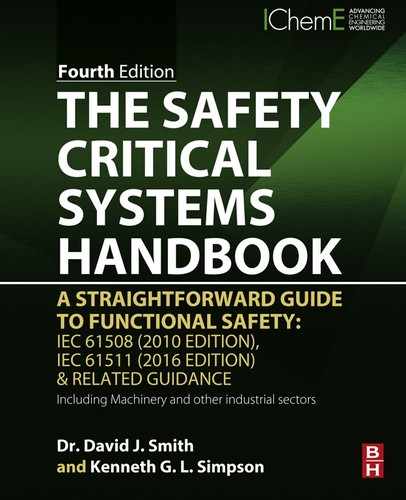Appendix 8
Some Terms and Jargon of IEC 61508
The seven “Parts” of IEC 61508 are described as “normative”, which means they are the Standard proper and contain the requirements which should be met. Some of the annexes, however, are described as “informative” in that they are not requirements but guidance which can be used when implementing the normative parts. It should be noted that the majority of Parts 5, 6, and 7 of the Standard are informative annexes.
A few other terms are worth a specific word or so here:
Functional safety is the title of this book and of IEC 61508. It is used to refer to the reliability (known as integrity in the safety world) of safety-related equipment. In other words it refers to the probability of it functioning correctly, hence the word “functional.”
E/E/PE (electrical/electronic/programmable electronic systems) refers to any system containing one or more of those elements. This is taken to include any input sensors, actuators, power supplies, and communications highways. Provided that one part of the safety-related system contains one or more of these elements, the Standard is said to apply to the whole.
ELEMENT: one or more components providing a safety function or part thereof.
EUC (equipment under control) refers to the items of equipment which the safety-related system being studied actually controls. It may well be, however, that the EUC is itself safety-related and this will depend upon the SIL calculations described in Chapter 2.
FSCA—see FSM.
FSM: functional safety management (previously referred to as functional safety capability assessment (FSCA).
HR and R are used (in IEC 61508) to refer to “Highly Recommended” and “Recommended”. This is a long-winded way of saying that HR implies activities or techniques which are deemed necessary at a particular SIL and for which a reasoned case would be needed for not employing them. R implies activities or techniques which are deemed to be “good practice.”
NR is used to mean Not Recommended, meaning that the technique is not considered appropriate at that SIL.
SOUP: software of unknown pedigree.
Verification and validation: verification (as opposed to validation) refers to the process of checking that each step in the life cycle meets earlier requirements. Validation (as opposed to verification) refers to the process of checking that the final system meets the original requirements.
Type A components (hardware or software): implies that they are well understood in terms of their failure modes and that field failure data is available. See Chapter 3.
Type B components (hardware or software): implies that any one of the Type A conditions is not met. See Chapter 3.
Should/shall/must: in standard work the term “must” usually implies a legal requirement and has not been used in this book. The term “shall” usually implies strict compliance and the term “should” implies a recommendation. We have not attempted to differentiate between those alternatives and have used “should” throughout this book.

FARADIP.THREE (£475 + VAT)
Described in Chapter 6, a unique failure rate and failure mode data bank, based on over 50 published data sources together with Technis's own reliability data collection. FARADIP has been available for over 25 years and is now widely used as a data reference. It provides failure rate DATA RANGES for a nested hierarchy of items covering electrical, electronic, mechanical, pneumatic, instrumentation, and protective devices. Failure mode percentages are also provided.
LOPA-PLUS (£299 + VAT)
Layers of protection analysis but involving quantified risk modeling in order to target safety integrity levels, carry out integrity (SIL) verification, and assess whether risks are ALARP. This is a user-interactive package, which enables users to input risk factors, demand rates, and the reliability of mitigation levels, in order to determine if risk targets are met. LOPA-PLUS ensures a fully quantified approach to risk targeting.
TTREE (£775 + VAT)
Used in Chapters 12–16, a low-cost fault tree package which nevertheless offers the majority of functions and array sizes normally required in reliability analysis. TTREE is highly user friendly and, unlike more complicated products, can be assimilated in less than an hour. Graphical outputs for use in word processing packages.
BETAPLUS (£125 + VAT)
Described in Chapter 5 and in Appendix 3, BETAPLUS has been developed and calibrated as new generation common cause failure partial β model. Unlike previous models, it takes account of proof test intervals and involves positive scoring of CCF related features rather than a subjective “range score.” It has been calibrated against 25 field data results, obtained by Technis, and has the facility for further development and calibration by the user.
Available from:
TECHNIS, 26 Orchard Drive, Tonbridge, Kent TN10 4LG
Tel: 01732 352532
Reduced prices for combined packages or for software purchased with training courses (Prices at time of press)
..................Content has been hidden....................
You can't read the all page of ebook, please click here login for view all page.
